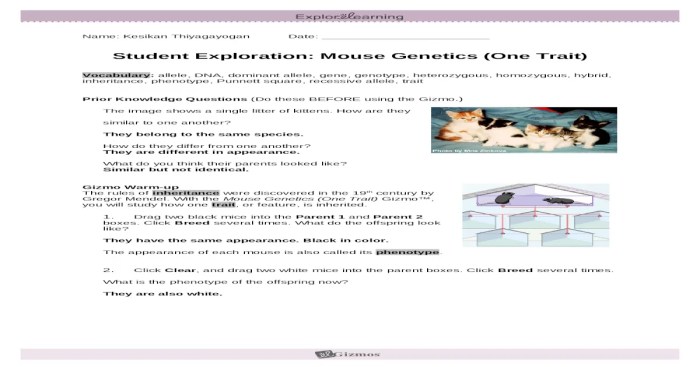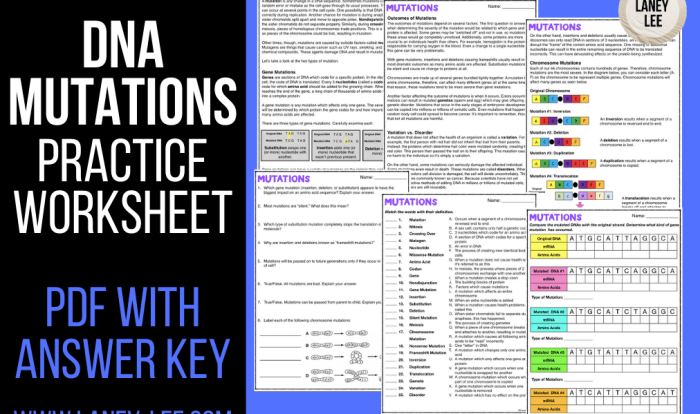Embark on a captivating exploration with the Student Exploration Mouse Genetics Two Trait Answer Key, a comprehensive guide that unlocks the intricacies of Mendelian inheritance in mice. This key provides an in-depth understanding of genetic principles, mouse genetics, two-trait crosses, data analysis, and the applications of mouse genetics in biomedical research.
Delve into the fascinating world of mouse genetics, where the inheritance patterns of coat color and eye color genes are meticulously examined. Discover the principles of dominant and recessive alleles, homozygous and heterozygous genotypes, and the fascinating world of Punnett squares.
Prepare to be captivated as we analyze actual results and discuss the implications of any deviations from expected ratios.
1. Genetic Principles
Genetic principles form the foundation of inheritance and variation in living organisms. These principles govern the transmission of genetic material from parents to offspring, determining the traits and characteristics of individuals.
Dominant and Recessive Alleles
Alleles are alternative forms of a gene that occupy the same locus on homologous chromosomes. Dominant alleles are those that express their phenotypic effect even when paired with a recessive allele. Recessive alleles, on the other hand, are only expressed when paired with two copies of the same allele.
Homozygous and Heterozygous Genotypes, Student exploration mouse genetics two trait answer key
A homozygous genotype consists of two identical alleles for a particular gene, while a heterozygous genotype consists of two different alleles. Homozygous dominant individuals (AA) will express the dominant phenotype, homozygous recessive individuals (aa) will express the recessive phenotype, and heterozygous individuals (Aa) will exhibit an intermediate or blended phenotype.
Mendelian Inheritance
Mendelian inheritance, based on the principles established by Gregor Mendel, explains the patterns of inheritance of traits from one generation to the next. Mendel’s laws of segregation and independent assortment describe how alleles are inherited and combined during sexual reproduction.
2. Mouse Genetics: Student Exploration Mouse Genetics Two Trait Answer Key
Mice have been widely used as model organisms in genetic studies due to their short generation time, large litter size, and well-characterized genome. They have contributed significantly to our understanding of fundamental genetic principles and human diseases.
Coat Color and Eye Color Genes
Coat color and eye color in mice are determined by specific genes. The agouti gene (A) controls the distribution of pigment, resulting in a variety of coat colors, including black, brown, and yellow. The albino gene (c) affects the production of melanin, leading to white fur and pink eyes.
Inheritance Patterns
The inheritance patterns of coat color and eye color in mice follow Mendelian principles. The agouti gene exhibits incomplete dominance, with heterozygous individuals (Aa) displaying an agouti phenotype. The albino gene is recessive, requiring two copies (cc) for the albino phenotype to be expressed.
3. Two-Trait Crosses
Two-trait crosses involve studying the inheritance of two traits simultaneously. This allows researchers to investigate the interactions between different genes and their effects on the phenotype.
Breeding Experiment
To study the inheritance of two traits, a breeding experiment is designed. Mice with different genotypes for the two traits are crossed, and the offspring are analyzed to determine the distribution of genotypes and phenotypes.
Punnett Square
A Punnett square is a tool used to predict the possible genotypes and phenotypes of the offspring from a two-trait cross. It involves arranging the alleles of each parent along the sides of a square and combining them to determine the potential offspring.
Results Table
The results of a two-trait cross can be organized in an HTML table with columns for genotype and phenotype. This table provides a clear overview of the distribution of traits among the offspring.
4. Data Analysis
Data analysis is crucial in interpreting the results of a two-trait cross. Researchers calculate the expected phenotypic ratios based on the principles of Mendelian inheritance and compare them to the actual results.
Expected Phenotypic Ratios
The expected phenotypic ratios are determined based on the genotypes of the parents and the principles of dominant and recessive alleles. These ratios provide a prediction of the proportions of different phenotypes in the offspring.
Actual Results
The actual results of a two-trait cross are obtained by counting the number of individuals with each phenotype and comparing them to the expected ratios. Deviations from the expected ratios can indicate genetic interactions or other factors influencing the inheritance of the traits.
5. Extensions

Mouse genetics has broad applications in biomedical research and beyond. Understanding the genetic basis of diseases in mice can provide insights into human health and lead to the development of new treatments.
Biomedical Research
Mouse models have been instrumental in studying human diseases, such as cancer, cardiovascular disorders, and neurodegenerative diseases. By manipulating mouse genes, researchers can investigate disease mechanisms and develop potential therapies.
Ethical Considerations
Using mice in genetic studies raises ethical considerations. Researchers must ensure the humane treatment of animals and minimize any potential harm or distress. Ethical guidelines and regulations are in place to safeguard the well-being of mice used in research.
Resources
- Mouse Genome Database: https://www.informatics.jax.org/
- International Mouse Phenotyping Consortium: https://www.mousephenotype.org/
- The Jackson Laboratory: https://www.jax.org/
FAQ Corner
What are the key concepts of Mendelian inheritance?
Mendelian inheritance revolves around the principles of dominant and recessive alleles, homozygous and heterozygous genotypes, and the predictable patterns of inheritance observed in offspring.
Why are mice considered valuable model organisms for genetic studies?
Mice possess a short generation time, high reproductive rate, and well-characterized genetic makeup, making them ideal for studying the inheritance of traits and the effects of genetic modifications.
How can Punnett squares be used to predict the possible genotypes and phenotypes of offspring?
Punnett squares provide a visual representation of the possible combinations of alleles that can be inherited from each parent, allowing researchers to predict the probability of different genotypes and phenotypes in the offspring.
